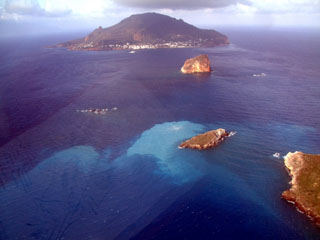Report on Panarea (Italy) — March 2003
Bulletin of the Global Volcanism Network, vol. 28, no. 3 (March 2003)
Managing Editor: Edward Venzke.
Panarea (Italy) Intense bubbling ends, but degassing continues through March 2003
Please cite this report as:
Global Volcanism Program, 2003. Report on Panarea (Italy) (Venzke, E., ed.). Bulletin of the Global Volcanism Network, 28:3. Smithsonian Institution. https://doi.org/10.5479/si.GVP.BGVN200303-211041
Panarea
Italy
38.638°N, 15.064°E; summit elev. 399 m
All times are local (unless otherwise noted)
On 3 November 2002, intense degassing caused bubbling activity near the small islet of Lisca Bianca, very close to the island of Panarea (BGVN 27:10). On 13-14 November 2002, observers Orlando Vaselli (University of Florence), Bruno Capaccioni (University of Urbino), and Piermaria Luigi Rossi (University of Bologna) noted 10 points of boiling water when they visited the area to sample gas emissions.
Geochemical monitoring and research is being regularly performed by the Fluid Geochemistry group from the Osservatorio Vesuviano (Istituto Nazionale di Geofisica e Vulcanologia), led by Giovanni Chiodini. Submarine gas emissions were sampled during 29-30 November and 10-17 December 2002, as well as 23-24 January and 9-11 February 2003. Samples obtained during March, April, and May have not yet been analyzed. Chiodini noted that although the intensity of emissions decreased after 5 November 2002 (BGVN 27:10), the gas flux remained much higher than before the November event. That observation, along with chemical variations in gas samples, indicate that the process is ongoing. Research results posted on the Osservatorio Vesuviano website provide additional details, analytical findings, and hypotheses about these phenomena.
Geological Summary. The mostly submerged Panarea volcanic complex lies about midway between Stromboli and Lipari in the eastern part of the Aeolian Islands. Panarea, the smallest island in the Aeolian Archipelago, lies on the western side of a shallow platform whose shelf margin is at about 130 m depth. A series of small islands breach the surface to form the Central Reefs, the rim of a crater 2 km E of Panarea, whose shallow submerged floor contains Roman ruins. The submerged Secca dei Pesci lava dome lies at the SE end of the platform, and the rhyolitic Basiluzzo lava dome rises 165 m above the surface at the NE end, along a ridge trending towards Stromboli volcano. The complex was constructed in two main stages: an initial effusive activity phase that produced lava domes, and an explosive stage. The youngest subaerial airfall-tephra deposits are dated to about 20,000 years ago; a date of less then 10,000 BP on a lava flow is uncertain. Vigorous hydrothermal activity has continued at fumarolic fields at several locations on the submerged platform; submarine hydrothermal explosions have occurred in historical time.
Information Contacts: Giovanni Chiodini, Unità Funzionale di Geochimica dei Fluidi, Osservatorio Vesuviano, Istituto Nazionale di Geofisica e Vulcanologia, Via Diocleziano, 328-80124 Napoli, Italy (URL: http://www.ov.ingv.it/); Orlando Vaselli, Dipartimento di Scienze della Terra, Universita' degli Studi di Firenze, Via La Pira 4, 50121 Firenze, Italy; Stromboli Online (URL: http://www.stromboli.net/).

